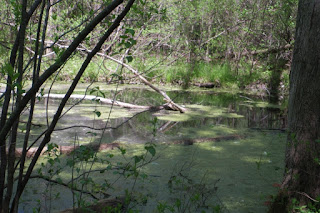On Saturday, May 20th, I participated in a guided hike through Buckhorn Island State Park. The guide was Dave, who works for New York State Parks, Recreation, and Historic Preservation.
The focus of this walk was wetlands. Dave said that there are four different types of wetlands, three of which can be found in Buckhorn Island State Park in Grand Island, New York. They are:
 |
| This is a swamp in Buckhorn Island State Park. There are no bogs. |
- bog: This is a fresh water wetland that was formed in old glacial lakes with a spongy peat base. The soil is acidic and low in nutrients. Plants that grow well in bogs include blueberries, day lilies, pitcher plants, cranberries, and orchids. There are no bogs in Buckhorn Island State Park or anywhere in Grand Island.
- swamp:

Dave describes common traits
of swamps.near rivers and their tributaries (creeks). They provide a nursery for ducks, frogs, fish, and salamanders. There are trees in or near the water. Tree types may include cottonwood and red maple. In the past, people thought that swamps were the source of disease. The reputation was undeserved.

Woods Creek Actually, swamps cleanse the waterways.
But people believed that swamps were bad and they wanted the swamps to be drained. That was the sad fate of many swamps, which have been lost forever.
The Niagara River The swamps are protected and preserved in Buckhorn Island State Park.
- vernal pool: they are created from melting snow and spring rain.
They are temporary bodies of water. There are species that can lay their eggs in vernal pools and nowhere else. They are called “obligate species.” They include Jefferson salamanders, blue spotted salamanders, and spotted salamanders. The babies hatch and start maturing in the water. They leave the vernal pools before they are dried, which is usually during the summer. Eggs can be viable in the dry mud of a vernal pool for several years. Another important characteristic of vernal pools is that there are no fish in the pools. These pools are temporary and would not support fish, who need a permanent aquatic environment. There is, however, a vernal pool in Buckhorn Island State Park that is considered to be “semi-permanent.”
- marsh: very rich and one of the most important wetlands. Much of Buckhorn Island State Park is underwater and is marshland.
The marsh in Grand Island is the largest remaining marsh on the Niagara River. Species that can be found around marshes include dragonflies, emerald minnow shiners, May apples, chorus frog wood frog, spring peepers, and more. The plants that grow in a marsh tend to be soft, while the plants that grow around a swamp tend to be woody.


Always good to go on such hikes with an expert. You learn a few things about the flora and fauna. I would love to go to a park like this. The pictures tell me you had a good time.